Foodborne illness is a common, costly–yet preventable–public health problem. Each year, according to the Centers for Disease Control (CDC), one in six Americans get sick from contaminated foods or beverages. As many as 3,000 people die from foodborne illnesses each year. Although there are many different microbes that cause foodborne illnesses, the CDC has identified 5 Risk Factors most commonly associated with foodborne illnesses. These risk factors apply to both commercial and home kitchens.
The 5 Risk Factors are:
An approved source is a facility that is inspected by the responsible regulatory agency and meets their standards. Most commonly, this refers to an agency such as the US Food and Drug Administration (FDA) for processed foods that aren’t meat or poultry or the US Department of Agriculture (USDA) for meat and poultry products. A food establishment is permitted to serve food to the consumer and cannot prepare and sell food to another food establishment. To further protect yourself when purchasing food, make sure the food is at the proper temperature when purchased, received or delivered, free of signs of pests (insects, rodent droppings, etc.), and that the packaging, if any, is intact.
Cooking raw foods of animal origin (meat, poultry, eggs, fish, etc.) is one way to kill microorganisms that can be in the food that can make you sick. Microorganisms that can make you sick cannot be seen, tasted, or smelled. Some can survive freezing and cooking. Spoilage microorganisms, on the other hand, make the food look, smell, or taste unappealing.
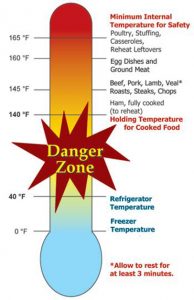 This chart shows some of the minimum internal cooking temperatures:
This chart shows some of the minimum internal cooking temperatures:
- Poultry (including whole or ground chicken, duck, turkey, stuffing, etc.) – 165°F for 15 seconds
- Ground meat (excluding poultry) – 155°F for 15 seconds
- Pork, fish, lamb,or eggs for immediate service – 145°F for 15 seconds
- Beef Steak (mechanically tenderized)- 155°F for 15 seconds
- Beef Steak (whole muscle beef) – 145°F on exterior
- Vegetables or fruits that are cooked & held hot – 135°F
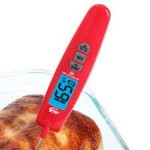
A good food thermometer is a critical piece of equipment for any cook. A digital food thermometer, such as the one in this picture, is accurate and easy to read. You can find these types of thermometers at any restaurant or kitchen supply stores or at stores like Wal-Mart, Target and most grocery stores.
Remember to clean your thermometer between uses and check the accuracy periodically.
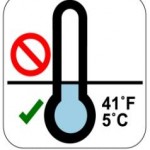 Bacteria that is found in food, that can make you sick, grow best at temperatures between 41°F and 135°F. When you keep cold food cold (at or below 41°F) and hot food hot (at 135°F or more) bacteria growth is slowed down. Ready-to-eat food will be safe to eat for up to 7 days after cooking or opening the commercially packaged food (unless dated otherwise by the processor). When you are preparing or serving food make sure to plan ahead so you can avoid letting the food remain in the TEMPERATURE DANGER ZONE (41°F-135°F) for more than a couple of hours. If food does sit out at room temperature for more than a couple of hours, discard all of the TCS food that remains.
Bacteria that is found in food, that can make you sick, grow best at temperatures between 41°F and 135°F. When you keep cold food cold (at or below 41°F) and hot food hot (at 135°F or more) bacteria growth is slowed down. Ready-to-eat food will be safe to eat for up to 7 days after cooking or opening the commercially packaged food (unless dated otherwise by the processor). When you are preparing or serving food make sure to plan ahead so you can avoid letting the food remain in the TEMPERATURE DANGER ZONE (41°F-135°F) for more than a couple of hours. If food does sit out at room temperature for more than a couple of hours, discard all of the TCS food that remains.
What is a TCS (Time/Temperature Control for Safety) Food? Simply stated, it’s a food that will support the growth of pathogens (bacteria that can make you sick) if held in the temperature danger zone for a period of time. Most people recognize foods like dairy products, meat and poultry, eggs, cooked fruits and vegetables, and seafood as TCS foods. It’s important to realize that foods like cut melons, cut tomatoes, bean sprouts, garlic in oil mixtures, and any cooked plant material are also TCS foods. So once you cut that tomato or melon, remember to get any portion of it that you don’t eat right away cooled down to 41°F or less as quickly as possible and no longer than 4 hours. Keep in mind that it is a lot harder to get foods cold than it is to heat them up! How long does it take you to make a cup of hot tea? How about an ice cube? When you want to cool leftovers from a meal, you can portion them into containers that are shallow and keep the lids off or loose until the food gets cold. Sometimes it makes sense to add ice or frozen vegetables to the food if you are going to make soup, too.
There are 3 main components to this risk factor:
- The health of the food handler
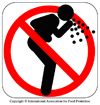 A sick food handler can easily spread their illness to others that consume the food. If you have vomiting, diarrhea, sore throat with a fever, or jaundice you should not prepare food until you’ve been symptom free for 24 hours. If you have an infected wound on your hands or exposed arms you need to bandage the wound and, if in a food establishment, wear disposable gloves. Food workers diagnosed with an illness caused by a BIG 6 pathogen: Salmonella Typhi, nontyphoidal Salmonella, Shigellos, Shiga toxin-producing E. coli(STEC), Norovirus, or Hepatitis A virus, must report the illness to the manager on duty. In most cases, the worker will be restricted from working until a health practitioner determines that it’s safe for the worker to return to work.
A sick food handler can easily spread their illness to others that consume the food. If you have vomiting, diarrhea, sore throat with a fever, or jaundice you should not prepare food until you’ve been symptom free for 24 hours. If you have an infected wound on your hands or exposed arms you need to bandage the wound and, if in a food establishment, wear disposable gloves. Food workers diagnosed with an illness caused by a BIG 6 pathogen: Salmonella Typhi, nontyphoidal Salmonella, Shigellos, Shiga toxin-producing E. coli(STEC), Norovirus, or Hepatitis A virus, must report the illness to the manager on duty. In most cases, the worker will be restricted from working until a health practitioner determines that it’s safe for the worker to return to work.
- Good handwashing practices
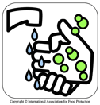 Washing your hands with soap and warm water for 15-20 seconds removes bacteria that you may have picked up on your hands that could be transferred to food or food contact surfaces. Always wash your hands after using the restroom, changing diapers, handling raw foods of animal origin, eating, drinking or smoking, or performing any task that may have contaminated your hands before you return to food preparation activities.
Washing your hands with soap and warm water for 15-20 seconds removes bacteria that you may have picked up on your hands that could be transferred to food or food contact surfaces. Always wash your hands after using the restroom, changing diapers, handling raw foods of animal origin, eating, drinking or smoking, or performing any task that may have contaminated your hands before you return to food preparation activities.
- No bare hand contact with ready-to-eat food (food establishment requirement)

As an added protection, food establishment food workers are required to avoid bare hand contact with food that is ready-to-eat. This can be done by using utensils, deli paper, gloves, etc. Single use gloves must be discarded after use and may not be reused.
There are several ways that food can become contaminated in a food establishment. Cross-contamination is when ready-to-eat food comes in contact with a surface or utensil that has been used with raw food of animal origin and hasn’t been cleaned an sanitized. The microorganisms from the raw animal food can get on the food that isn’t going to be cooked before consumption and make whoever eats that food sick. Use care to separate raw animal foods from foods that are ready-to-eat.
Dirty equipment and utensils can also transfer microorganisms to food and cause a foodborne illness. Wares must be clean to sight and touch. In a food establishment, wares must be washed in soapy water, rinsed in clear water, sanitized by heat or chemical means, then air dried before reuse and at specified intervals throughout the day, if in continuous use.
Reminder: If you suspect you are ill from something you ate, contact your local health department. The health department epidemiologist and environmental health specialist (inspector) will work together to learn about your illness and investigate the possible causes.
